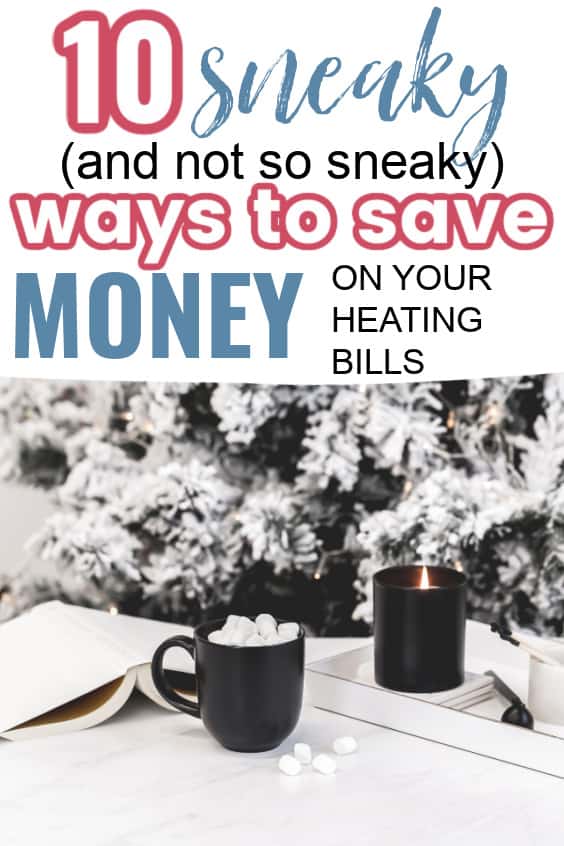How To Winterize A House On The Cheap
As the days and nights get colder, those of us living in colder climates can definitely feel the pinch when we get our heating bills. Luckily, it is possible to winterize a house on the cheap without resorting to new windows or insulation.
With the easy tricks below on getting your home ready for the cold, your home stay warm and toasty and you will see some nice savings in your heating bills.

This page contains affiliate links meaning I earn a commission if you use those links. Please read my disclosure for more information.
RELATED POSTS
27 Genius Ways To Save Money At Home
How To Save Money Eating Out At Restaurants
While some of the best ways to winter-proof your house include getting new windows, an energy efficient furnace and beefing up your attic insulation, the tips below are all aimed at helping you get through winter without spending big on new items for your home.
How much can you save by winterizing your house?
You could save you 10% or more on your heating bill by getting rid of drafts and improving your home’s efficiency.
10 Ways To Winterize A House on the Cheap
1.Wrap up
Cost: FREE
While this is not exactly a winterizing tip, it will help you safe on your heating bills.
Bundle up in sweaters and fluffy socks when you are at home. You shouldn’t be keeping your house so hot in the dead of winter that you can run around in shorts and a tee. Invest in flannel sheets and PJs for nighttime.
Consider cheap tricks such as a hot water bottle in bed 30 minutes before you get in or a heated throw blanket to ward off the chills. This sherpa blanket from Amazon is a bestseller and gets great reviews.
Always wearing slippers in the house can make a big difference too and make sure to switch out your comforter for a down-filled thick one as soon as the cold air arrives.
Get a heating blanket for your bed or even use a hot water bottle. Turn it on when you wake up and lay your clothes under it while you shower. Do the same with pajamas at night.
You can save more money by making your own microwaveable rice warmer and using that instead of a heated blanket. It’s good for children’s beds where you don’t want to risk any burns.
2. Fix drafts and air leaks
Cost: $0-$500 depending on what options you choose.
This is the number one thing you should do when think of ways to winterize a house in preparation for the cold weather. Even new builds may have drafty doors or windows.
If you live in an older home that needs new windows, these tips can help you last a few more winters before you have to shell out the big money.
Check for leaks using a lighter or candle held up to the window and look for the smoke drifting sideways.
Fixing leaks is a multi-part process but it arguably the most important thing you can do to winterize your house if you are on a budget.
Check the following areas in your house before you begin:
- Outside Caulking around doors and windows ($$$)
- Inside caulking around windows ($)
- Window closures to make sure they are sealing properly. ($)
Outside Caulking
Caulking around the outside of your windows and doors typically lasts about 10 years. If your caulk is looking cracked and rock hard, then it is likely time to switch it out.
You can try to do it yourself using professional grade silicon caulk or you can hire this job out. While this is expensive, if you really want to winterize your house, it may have the biggest impact.
The toughest part is removing the old caulk which is normally really stuck on there.
We hired professionals to recaulk the outside of our house this past year and average cost was $50 per opening.
In theory if the caulk in your house is updated and your windows are still working fine, this should avoid you having to get new windows for a few years so is great if you are tight on money.
Cost: $500
Inside Caulking
This was a step that I ignored until the first cold day this year as I thought the outside caulking had solved all my issues. Unfortunately, you also need to check the inside caulking around your windows.
One of my windows had a half inch gap between the wall and the bottom of the window frame that was just leaking cold air inside the house.
Take some time to caulk around all your windows on the inside and it could really make a difference to your heating bills.
Cost: $10 for caulk
Moveable Window Parts
Close all your windows and check for gaps in the seal. I found that some of my older windows just don’t seal properly and needed to be filled with tape or removable caulk (you need the removable caulk so you can open the windows next summer!).
You can fix the small gaps easily with Self Adhesive Foam Weatherstrip Seal. It comes in rolls and you just cut it to size and stick on the drafty seam. It comes off easily in the spring.
If you don’t want to use the sticky strip (I find it comes off easily on windows that get a lot of condensation), you can try LePage’s No More Drafts if you can find it (I got it from Amazon.ca). It’s a clear gel-like liquid that is used like caulk.
I find it good value if you need to winterize a house with very old windows as buying the foam adds up if you need to buy al lot.
I used it on my daughter’s room that was getting frost on the inside of the window and it has made a huge difference!
My only negative review of No More Drafts is that it smells quite strong for the first 24-48 hours so if you are sensitive or want to go chemical-free, then stick to the weather strip tape above.
Another option that I am trying this year with good results is the 3M Interior Transparent Weather Sealing Tape. It’s good for areas where you don’t want the unslightly look of regular sealing foam. It looks just like regular scotch tape.
In addition to windows, make sure to check exterior doors and interior garage doors. You can use the foam sticky strips around the door to block any drafts and even buy a simple self-adhesive door sweep to block cold air.
If you want to go old school and really thrifty, cut an old pair of tights (with feet) in half and stuff one leg with old socks or clothes. Tie up the open end and you have a DIY draft-excluder for the bottom of your door.
Our front door has a pretty good seal, but there are still a few spots where you can feel a chill of air coming in. Especially during a storm. We usually throw a rolled beach towel down at the base of the door to block the draft.
I like how a towel can be tossed in the wash every few days, and easily removed if we have guests.
Another common place for leaks is electrical outlet boxes, you can take the front plate off and fill with caulk to stop drafts. You can also buy socket sealers that fill the gap inside the sockets.
3. Make the most of existing heat sources
My not-at-all thrifty husband taught me this one when we first moved in together. If you make pasta or boil eggs in water on the stove top, leave the pan of water out once you have turned off the element. The water will give off heat for quite a while.
Likewise, when you are done using the oven, leave it open a smidgen so that the heat warms up the room.
Another tip is to put foam covers on your hot water heater pipes to keep the heat in. This is sometimes not recommended for gas water heaters so make sure to check with the utility company first.
4. Get a furnace tune-up
Ideally, you should have your heating unit serviced every fall to avoid any issues once the cold hits. The technician can make sure your unit is working as efficiently as possible thus saving you money.
If you need a new furnace, make sure to look for energy-saving rebate programs that can halve the cost of your new appliance.
Make sure you change your furnace filter every 3 months all year long.
5. Cover Windows
When winterizing a house. consider covering windows as they are a huge source of heat loss.
What can you put on windows to keep cold out?
You can use thick blackout curtains at night to prevent drafts from escaping.
Also, consider buying Window Shrink Film to put on your windows. It takes minutes to apply and acts as an invisible layer that can keep heat in your house and save your bills.
I always use the window shrunk film in addition to the weather stripping tape and it blocks all drafts out.
For a budget version, you can tape bubble wrap to the inside of your windows. The only downside with that is that you wouldn’t be able to see out of the windows all winter. It does work just as well though.
6.Check your thermostat
Pay attention to where your heat registers are in relation to your thermostat.
Our thermostat is in the hall, directly across from our guest bathroom. We have to keep the vent closed in that bathroom because if we don’t the heat builds up in the small area and the thermostat thinks it’s several degrees warmer in the rest of the house and the heat won’t come on.
One thing I am trying this year are the Heat and Air Deflectors. They force the air from the vents to go towards the room instead of up/out which is handy if you have vents near the windows. They are just simple plastic covers you stick to the vents with magnets.
With a Programmable Thermostat, you can lower the temperature in your house for the hours you are gone during the day and then warm things up when you are home. You can save a lot of money by being smart about not heating an empty house.
You can buy thermostats for under $50 like this one by Honeywell or fancier ones like the Nest Learning Thermostat
that automatically turns the temperature down when no one is home. It can also be controlled via mobile or laptop.

 7. Open the blinds
7. Open the blinds
This is a completely free way to winterize your house on the cheap!
On sunny but cold days, open your blinds and let the sun naturally warm your house through the glass. I notice an almost 5-degree difference in my south facing sunny rooms compared with the colder rooms in my house.
Take advantage of the free heating!
8. Cover those floors
Hardwood and tile may be in fashion but they don’t hold the heat like a carpet does. Add thick rugs to hardwood floors to keep the heat in, especially for rooms over garages and porches that can be freezing in the winter.
9. Turn your thermostat down a notch
Even turning the temperature down a couple of degrees can shave up to 10% off your heating bill. If you add the sweaters and socks mentioned in tip 1, you may not even notice the change.
10. Close off unused rooms
Before you spend a lot of money on items to winterize your house, evaluate the rooms that you actually use.
If you have rarely used rooms in your house, close off the heating vents and shut the doors. Less space to heat = lower heating bills.
The same goes for keeping the basement door closed or installing a door if you don’t have one.
However, make sure you do heat the basement as the heat will rise to the first floor of your house and you don’t want your pipes to freeze anyway!
More Money Saving Tips:
5 Winter Hacks That Will Get Your Through To Spring
31 Clever ways to save money and live better














One tip that works for me is using child safety outlet plugs in all of my electric outlets. I have little ones so I would do it anyway, but I’m always amazed how much cold air comes out when I remove them. And for a couple of bucks for a dozen or two, they’re definitely frugal!
Hi Amanda, sorry for replying so late – so I just moved house and it is so drafty so I tried your tip out, hopefully it reduces my heating bill even more, it’s -15 here today! Thanks for the awesome tip!
Thanks for sharing! I love to bundle up in the winter! It’s how I justify spending a little more on warm sweaters and scarves!
Haha, thats a good way of looking at it Vanessa!
This was a good read! We can save so much when we adapt to the cold and learn to live with it just a bit colder. Eventually , we adjust!
I agree, Suzanne, thanks for your comment.
These are great tips that make me think of my days back in Buffalo. I do not miss being quite that cold.
These are great tips. Also, they have heated floors now that have become quite popular.
Thanks for your comment, Betty. My only hesitation with heated floors (which I would love!) is the cost. I don’t think they are a frugal option but otherwise, they would be amazing! Especially in the bathrooms. Awesome for our Canadian winters up here.
My parents used the window shrink film for YEARS before they could afford new windows and I always found it embarrassing, lol. But now that I own a home I totally get it! Thanks for sharing these great tips!
Haha, yes my husband absolutely hates that shrink wrap stuff and thinks that I am ridiculous. I haven’t quite succumbed to the bubble wrap yet!
Thank you for your comment!